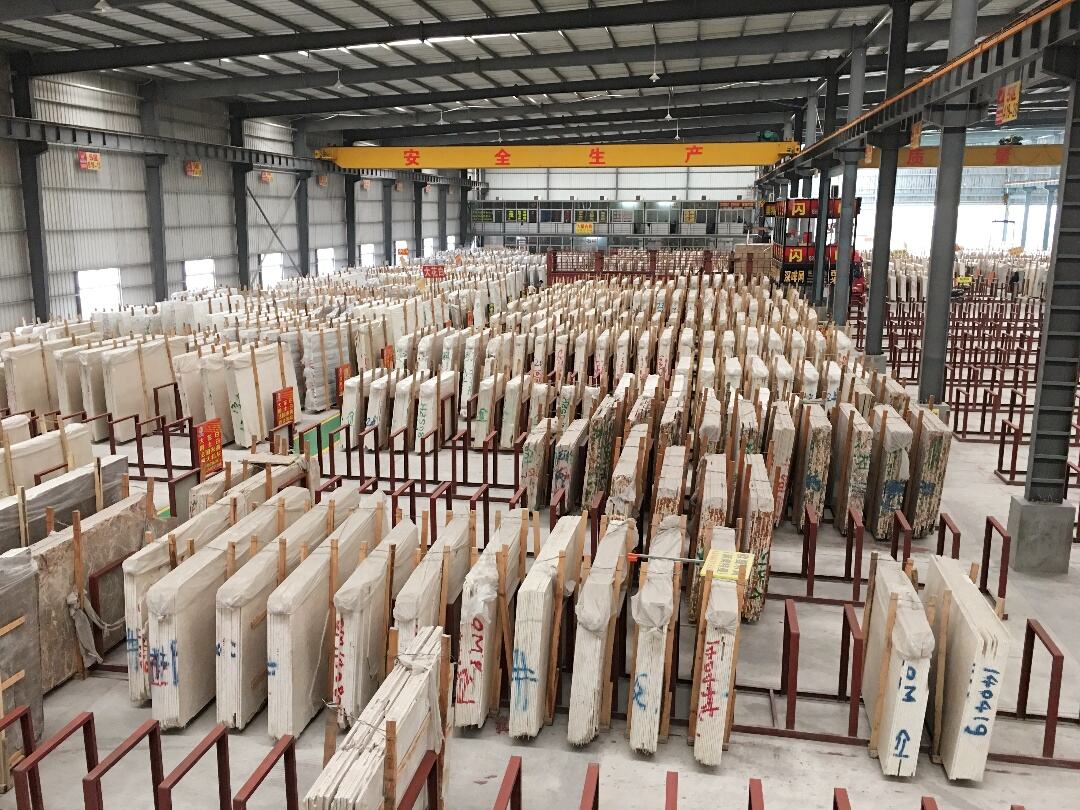Assessing Marble Quality and Certifications from Your Supplier
Key indicators of high-quality marble: veining, density, and finish
Good quality marble typically shows even veining patterns without those jarring color jumps we sometimes see. The rock itself packs around 2.5 to 2.7 grams per cubic centimeter according to ASTM standards, and can achieve that beautiful mirror finish when properly polished. Marble slabs that fall under 2.3 g/cm³ tend to soak up stains much easier because they're simply more porous. When looking at finished products, inconsistent surface textures usually mean the manufacturer cut corners somewhere during processing. Want to check marble quality on site? Many professionals swear by the old lemon juice trick. Just squeeze some fresh citrus onto the surface and watch how it reacts over time. This simple test reveals both etching tendencies and absorption rates without needing fancy lab equipment. All these factors matter a lot for long-term performance, particularly in commercial spaces where foot traffic wears down materials day after day.
How to examine samples for consistency and defects
When looking at stone options, it makes sense to ask for full-size samples at least 2 feet by 2 feet so we can really see how the veins run together in the actual lighting conditions of the space. Give those samples a good spin around in your hands too. Sometimes there are hidden cracks underneath the surface or areas filled with resin that look okay at first glance but actually shorten the life of the slabs by somewhere around 40%, according to research from the Natural Stone Institute back in 2023. Be wary of suppliers who only hand out those tiny showroom samples though. They might not show the true range of what comes out of a particular batch. For big projects where everything needs to match visually across many tiles, this kind of variation between batches can be a real problem down the road.
Common defects to avoid in marble slabs
| Defect Type | Impact | Detection Method |
|---|---|---|
| Calcite Streaking | Compromises structural integrity | UV light inspection |
| Surface Pitting | Accelerates wear and staining | Tactile examination |
| Color Bleeding | Disrupts aesthetic uniformity | 72-hour water exposure test |
Industry standards and certifications that ensure quality assurance
Construction sites see about 23% fewer rejected materials when working with ISO 9001 certified suppliers according to data from the Global Stone Congress in 2022. Beyond basic certification, it’s worth looking at other standards too. For example, NSF/ANSI 373 covers sustainability aspects while EN 14617 deals specifically with how materials hold up against impacts. The Marble Institute of America has developed quality assurance guidelines that many professionals rely on to verify paperwork and ensure proper testing methods are actually being followed in practice.
The importance of traceability and documentation in sourcing
Digital quarry certificates with GPS coordinates are becoming a must these days. According to Stone Federation data from 2023, about three-quarters of all fabrication waste comes down to those tricky vein inconsistencies that go unrecorded. When materials arrive at the site, make sure each batch has its own Certificate of Analysis showing how much water it absorbs and what kind of bending stress it can handle. Top design companies aren't just asking for this stuff anymore—they demand it. Many have started using blockchain technology to track where stone actually comes from throughout the entire supply chain. This helps cut out confusion and keeps everyone responsible for their part in the process, which matters a lot when projects need to last decades rather than just years.
Evaluating Supplier Inventory: Variety, Availability, and Lead Times
Why Range of Colors, Finishes, and Slab Sizes Impacts Project Flexibility
A diverse inventory enables architects to meet exact design specifications without costly compromises. Suppliers offering 15+ marble varieties and multiple finishes—polished, honed, brushed—support custom layouts while minimizing waste. Limited selections increase the risk of mismatched slabs, contributing to delays in 34% of remodeling projects (Stone Industry Report 2023).
Stock Rotation Practices for Popular and Rare Marble Types
Top suppliers use just-in-time restocking for high-demand marbles like Calacatta Gold, while reserving quarried blocks for rare varieties. This strategy maintains availability without overstocking, crucial given the $180—$400/slab market volatility and extended lead times for exotic materials.
Understanding Lead Times and Availability for Custom or Imported Marble
Imported marble now faces average lead times of 6—10 weeks due to digitized customs processes. Suppliers maintaining 30—45 days of buffer stock at port-adjacent warehouses achieve 98% on-time delivery rates, significantly outperforming inland distributors at 72% (DDMRP Study 2023). Direct access to shipping hubs ensures faster turnaround for premium imports.
How Inventory Management Reflects Supplier Reliability
Suppliers with real-time inventory tracking systems provide portal access to live slab data, reducing specification errors by 40% compared to manual reporting methods. This transparency helps prevent costly rework, often exceeding $15,000 per project, and strengthens confidence in large-scale procurement.
Analyzing Supply Chain Strength and Logistics Capabilities
The Role of Logistics Networks in On-Time Delivery Performance
According to the Global Logistics Institute from 2023, companies that have their logistics all tied together hit around 89% on-time deliveries for commercial stuff, while others stuck with broken up transportation systems only manage about 63%. When things go wrong at ports or when bad weather hits, having regional warehouses nearby makes all the difference. These centers can quickly redirect shipments so precious stone materials don't get damaged in transit. And these days, thanks to real-time GPS tracking combined with blockchain records, we can actually track individual slabs throughout their journey. Luxury property builders report installation holdups dropped by roughly 18% after implementing this kind of detailed monitoring system across their supply chains.
International Sourcing and Port Access: Key Advantages for B2B Buyers
Getting direct access to ports can cut down on import wait times anywhere from 12 to maybe even 22 days instead of going through those third-party freight companies. Makes all the difference when trying to get hold of those rare marble stones coming out of crowded Mediterranean spots such as Carrara itself. The top players in the industry have figured out ways around the red tape too. They work with these prepaid duty schemes and partner up with free trade zones across both Asia Pacific and European Union territories. According to Maritime Trade Review last year, this approach gets things moving at around 97 percent efficiency most of the time.
Case Study: Mitigating Supply Disruptions in Luxury Construction Projects
When a hotel developer in Dubai faced delays over 35,000 square feet worth of Emperador Dark marble, they struck an agreement with a supplier who maintains stock in both Jebel Ali and Rotterdam. By working with slabs already quarantined according to UAE irradiation rules, plus getting waterjet cuts done as needed and relying on certified documentation through blockchain technology, the project stayed on track with timely deliveries. This clever approach cut down shipping expenses by around twenty percent and prevented nearly three quarters of a million dollars in possible penalties according to Luxury Construction Quarterly from last year.
On-Site Audits and Factory Inspections as Indicators of Operational Transparency
Projects using audited suppliers report 43% fewer material defects (Construction Materials Group 2023). Key audit criteria include:
| Audit Criteria | Compliance Impact |
|---|---|
| CNC cutting calibration | ±0.5mm tolerance |
| Climate-controlled storage | 99% crack prevention |
| Waste recycling protocols | LEED certification eligibility |
Third-party inspectors increasingly use AI tools to verify grading consistency, with 92% of audited suppliers meeting ISO 22007 thermal compliance for exterior applications.
Balancing Cost, Value, and Pricing Transparency
How Competitive Pricing Reflects Supplier Efficiency and Market Position
Competitive pricing often reflects operational efficiency and strong market positioning. Vertically integrated suppliers typically offer 10—15% lower rates than intermediaries by streamlining extraction and reducing waste (2024 industry benchmarks). However, price alone should not override quality considerations.
Hidden Costs in Marble Procurement: Shipping, Handling, and Fabrication Waste
Base prices rarely reflect total project cost. Unbudgeted expenses—such as international shipping ($18—$25/sq.ft), handling damage, and fabrication waste—cause 23% of marble projects to exceed budgets (2023 analysis). Always request detailed breakdowns covering crating, insurance, and disposal fees to avoid financial surprises.
Trend: Increasing Transparency in Marble Pricing Models
Over 67% of B2B buyers now favor suppliers with open-book pricing models that support real-time cost tracking and audit readiness. Forward-thinking providers disclose quarry-to-factory transportation, custom cutting surcharges, and volume-based discount tiers, enhancing trust and planning accuracy.
Value Over Price: Long-Term Savings Through Consistent Quality
Choosing the lowest bidder risks costly failures—an average penalty of $740,000 in luxury projects using substandard marble (Ponemon 2023). Suppliers emphasizing documented QA processes and ASTM-certified materials reduce total ownership costs by 29% over five years. True value lies in reliability, longevity, and minimized lifecycle expenses.
Building Trust Through Customer Support and Long-Term Partnership
Responsive Communication and Technical Support During Installation
Top suppliers offer 24/7 technical support for issues like slab alignment or substrate prep. According to PwC's 2024 Trust Survey, 93% of executives link proactive engagement to improved outcomes and loyalty. Dedicated portals or onsite teams resolve 89% of queries within four hours.
Access to Material Specifications and Guidance for Architects and Contractors
- Provide ASTM test reports for abrasion resistance (≥15,000 cycles) and water absorption (<0.20%)
- Share CAD files showing vein patterns for accurate digital mockups
- Distribute ASTM C503-compliant fabrication guidelines for complex finishes
Strategies for Developing Long-Term Partnerships With a Marble Supplier
Contractors favor suppliers who hold quarterly planning sessions to align inventory with upcoming projects. A 2023 study found that 78% of luxury firms renew contracts with partners offering transparent defect tracking and volume incentives, reinforcing stability and predictability.
Principle: Trust, Consistency, and Mutual Growth in B2B Relationships
Leading suppliers retain 92% of clients annually by establishing client advisory boards and joint waste-reduction initiatives. This collaborative model cuts material overage costs by 18% (Marble Institute 2023) and ensures consistent quality across multiple builds, fostering enduring professional relationships.
FAQ
What are key indicators of high-quality marble?
High-quality marble typically displays even veining patterns, appropriate density (2.5 to 2.7 grams per cubic centimeter), and a flawless finish when polished. Lower density marble might indicate higher porosity and susceptibility to staining.
How can I check the quality of marble on-site?
Professionals often use the lemon juice test to evaluate marble. Simply apply fresh citrus juice to the marble's surface and observe the reaction for etching tendencies and absorption rates.
What certifications should I look for in a marble supplier?
Look for suppliers with ISO 9001 certification and additional standards like NSF/ANSI 373 for sustainability and EN 14617 for material toughness. These certifications ensure higher quality assurance and fewer rejected materials.
Why is traceability important in sourcing marble?
Traceability helps track the origin and journey of marble, ensuring each batch meets quality standards. This transparency aids in minimizing waste due to vein inconsistencies and enhances accountability within the supply chain.
What are the benefits of transparent pricing models in marble procurement?
Transparent pricing models, like open-book pricing, allow real-time cost tracking and audit readiness. This transparency builds trust, aids in planning accuracy, and helps prevent unexpected project costs.
Table of Contents
- Assessing Marble Quality and Certifications from Your Supplier
- Evaluating Supplier Inventory: Variety, Availability, and Lead Times
- Analyzing Supply Chain Strength and Logistics Capabilities
- Balancing Cost, Value, and Pricing Transparency
- Building Trust Through Customer Support and Long-Term Partnership
- FAQ

